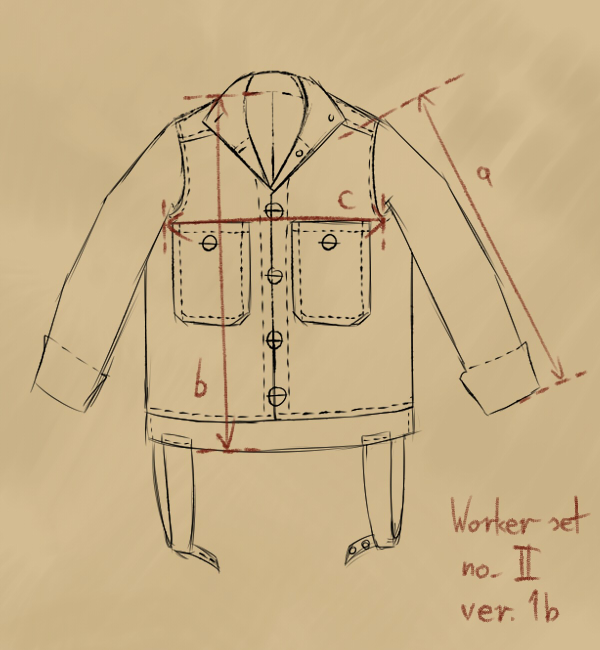Tyazhel chintz
If you go to any factory, no matter if here or anywhere else, it is most probable that you'll find at least one worker wearing a suit made out of this textile. This is how widespread it is. an owner of a retailer that deals tyazhel chintz clothing
Properties
Material Characteristics
Relatively stiff, woven textile of a light grey colour.
Origin & Source
The fabric is made out of Tyazhel cotton which comes from bushes grown all throughout the northern hemisphere.
History & Usage
Everyday use
The material's usage is mostly determined due to its durability and resistance to tearing, paired with a soft to the touch surface which makes the textile comfortable to wear. Both these characteristics make the tyazhel chintz for perfect use in working apparel for factory workers or any other physical jobs.
As it is relatively heavy when compared to most commonly used fabrics in the clothing industry, the tyazhel chintz is scarcely used as a primary material for everyday attire. Its usage in this business is closely tied with small decorative elements on things such as dresses or jackets.
Refinement
Harvest
To create the chintz, tyazhel cotton has to be first collected. This is usually done by hand, despite the fact that special vehicles do exist to mass-collect the cotton. The reason for that is the first machines that had been introduced kept on damaging the bushes while harvesting and thus have repelled farmers from using them. This bad word has stuck to them in this agricultural field and so despite the great technological advances in the machines, they are still seen as unreliable.The harvest usually occurs during late summer when most of the tyazhel cotton has matured. It's done in the noon to evening hours as the hot temperatures ensure that any moisture from dew or any other source has entirely or mostly evaporated (this helps with storage). The cotton bolls are picked and then stored in large quantities in big barrels placed near a source of warmth.
Drying
The cotton bolls are taken out of the barrels and put through a drier which consists of a moving belt and a furnace. The bolls make their way down the belt and get heated up, ending up in baskets that are then carried over to the next station of refinement.Cleaning and seed removal
The bolls consist of seed and fibre (called the lint), to which dirt or leaves might have also been mixed in. Before the cotton can be processed into a fabric, it is necessary to separate the fibre from everything else. This is done by first throwing the bolls into a spinning cylinder in which all the trash is shaken off them and then being filtered out by a sieve when the contents of the cylinder are released. The clean bolls are then moved to a special machine that through a series of metal rakes pull the lint away from the seeds. It then travels into containers in which the fibre is compressed into a more transportable shape.Spinning and woving
The transported fibre is cleaned again with warm air and combed. Next, it is thrown into a machine that presses it down and then separates into a few strands that then get twisted and rolled onto rotating pillars. From there the spun yarn is woven on looms, either manned or mechanised.Glazing
The last part in the creation of the tyazhel chintz is covering the fabric with a thin layer of tree resin and putting it through heated rollers. This gives the textile a stiffer and shinier look, as well as increases its durability.Manufacturing & Products
Everything from blankets and curtains to shirts and hats can be made out of the chintz. The widest usage it has found is in worker apparel, as it is comfortable and durable.
Byproducts & Sideproducts
During the refinement, a lot of tyazhel cotton seed is gathered as a sideproduct. Due to its relatively nutritious contents, it is used as livestock feed. It's possible also to grind the seed into oil which has found usage in the food and mechanic industries.
Hazards
The material is flammable and can easily be dissolved with any acid. Worker clothes made out of tyazhel chintz should thus be only worn in a controlled workspace environment.
Distribution
Trade & Market
The biggest exporter of the fabric is the Republic of Nazwa, as it is estimated that it's from there that almost a tenth of total international production comes from. Besides, the tyazhel chintz is made all across the northern parts of both the Central and Eastern continents. Its distribution is worldwide with many different companies dealing the bare fabric or investing more and selling clothing.
Type
Textile
Color
If not coloured during refinement, the tyazhel chintz is of light gray colour.
A design sheet with a worker jacket intended to be made out of the tyazhel chintz
Remove these ads. Join the Worldbuilders Guild










Comments